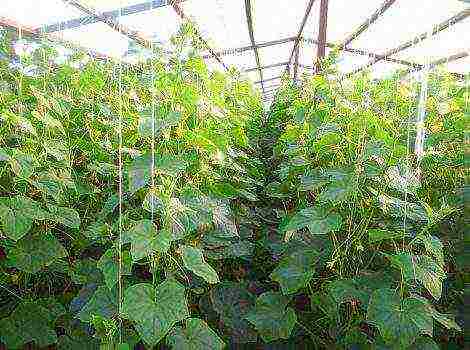Content [show]
Walnut is the strongest tree in the Walnut family. It has a long life cycle. The homeland of the plant is warm countries, but today it can be grown in the middle lane.
Walnut is an unpretentious, cold-resistant plant, therefore it is very often planted as a valuable fruit and ornamental crop.
Description of the plant
The walnut has two sexes and is pollinated by the wind. Male buds are located on lateral branches, gather in inflorescences. Their pollen spreads within 100 m and more. Female-flowered buds are based on the tips of one-year-old young shoots. Sleepers are on the central branch. If the aerial part is damaged, they restore the plant.
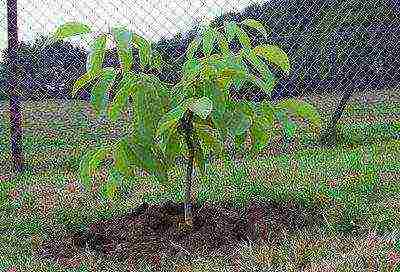
Young walnut tree
Diverse flowers do not bloom at the same time on the same tree, for this you need to plant varieties of different types of flowering in the same area in order to get a harvest. This is how cross-pollination is carried out. If this is not possible, it is necessary to graft a stalk from a different variety to the crown of the tree.
Character traits
Walnut loves warmth. There are many plant varieties that can tolerate short-term temperature drops of up to –25 ° C. If the temperature drops to –30 ̊С, one-year-old shoots freeze and become damaged.
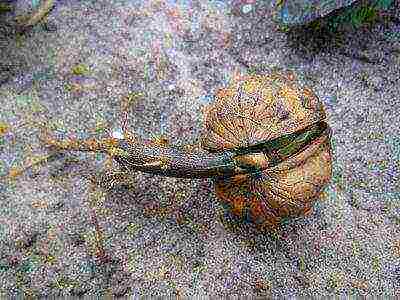
Nut sprouted
The most dangerous are spring frosts. Even with the slightest drop in temperature, young shoots die. The walnut tree in the middle lane is being restored with the help of dormant buds.
Considering the plant's shortcomings, scientists have developed different varieties that can withstand winter and frost. They are:
- weak - 8 meters;
- dwarf - 5 meters.
Resistant and fruitful are the varieties "Ideal", "Osipov". The first has several advantages:
- super-rapidity;
- winter hardiness;
- the kernel tastes pleasant and sweetish, the shell is thin.
This variety is popular not only in Russia. New varieties of hybrids have emerged that contain the properties of the "Ideal".
The cultivation of walnuts in Central Russia is carried out with additional manipulations. So, in winter they are covered with snow.
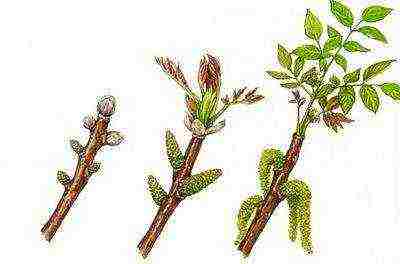
Walnut sprouts
Seating methods
Walnuts are transplanted in several ways:
- seeds;
- vaccination;
- using cuttings;
- layering.
Common cultivation of walnuts is by seeds. With this method, the plant receives 80% of the varietal characteristics. In this regard, the tree must be grafted. To grow a plant in central Russia, frost-resistant, high-yielding, large-fruited seeds are selected. They last no more than a year. When planting in autumn, the seeds of a walnut do not need to be dried, much more worries during spring sowing.
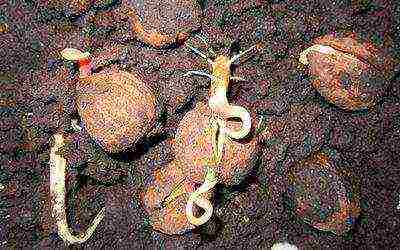
Sprouted nuts
Growing vegetatively ensures a good nut. When grafting a tree, young branches are used, which have large vegetative buds.
It is possible to grow a nut in central Russia by bending the layers and additionally covering them with snow.How the process is carried out can be seen in the photo.
Planting seeds
Planting walnuts in the middle lane is carried out in autumn and spring. Before spring planting, it is necessary to inspect the material, selecting unsuitable specimens. The roots of the remaining seedlings are processed. How the process takes place is shown in the video.
The planting pit is being prepared in the fall. It must be fertilized:
- humus;
- peat;
- superphosphate;
- potassium chloride;
- dolomite flour;
- wood ash.
Planting a plant with such fertilizer will provide him with the necessary nutrition for 5 years. Autumn is more suitable for planting in the southern parts of the country.

Planting a sprouted nut in the ground
Landing requirements
To be effective in producing fruits, you need to know how to choose the right soil. Any soil is suitable for growing a tree. She must be:
- fertile;
- loose;
- drained.
The walnut is planted on clay soil, where the acidity is low and the groundwater is low. Plots of land with strong compaction and waterlogging are not suitable for growing a plant.

Young sprout of walnut
We must not forget about the useful elements that the earth should receive. With this care, the tree fully develops. The necessary trace elements are found in special fertilizers and green manures.
Judging by the reviews, in the middle lane it is impossible to do without fertilizing the soil.
Care
Walnuts growing in Russia need proper care. It includes the following points:
- Pruning. The procedure is carried out in two stages. The first is in the spring. For the northern strip of Russia, the end of March is more suitable. The second stage is in the fall.
- Watering. A young tree needs it, the roots of which have not yet reached the groundwater.
- Whitewash. "Wounds" on the trunk are treated with copper sulfate. Whitewashing is done with garden lime in the spring.

Young shoots of a tree
Based on the reviews, scrupulous care increases the productivity of fruiting.
Spring frosts are considered the main danger for growing walnuts. Therefore, you need to choose early ripening varieties.
Adhering to these recommendations, you can easily grow a tree in Russia.
Usually this is a huge, by our standards, tree up to 25 meters to Greece it has a very indirect relationship: the fruits were brought from the south, and "Greece has everything." Surely, it also grows there, wild forms of this tree are common in Europe.
The tree looks impressive. A separately growing nut not only differs in height - its crown also reaches a diameter of 20 meters.
By European standards, he is a long-liver (second after oak) - specimens of 300-400-year-old trees are often found.
The development of the tree begins with the formation of a powerful taproot, which reaches 1.5 meters in depth at the 5th year and 3.5 meters by the age of 20.
Horizontal ones do not grow immediately - they are formed after the core, located in the surface layer of the soil at a depth of 20-50 centimeters.
The tree begins to bear fruit after 10 years of life, and from the age of 30-40, the time of full fruiting comes.
If trees grow in groups, partially shading each other, they rarely yield more than 30 kg of yield, while a free growing nut can yield up to 400 kg of nuts.
But such cases are rare, only a tree 150-170 years old is capable of such a harvest. Usually an adult tree 25-40 years old in Moldova gives 1500-2000 fruits or 2000-2500 in the Crimea.
Moscow region, central Russia - where else can you plant and grow walnuts
They are found in the European part from the foothills of the Caucasus to St. Petersburgwhere the northernmost nuts in Russia grow. But these are isolated cases, exceptions that only confirm the rule.
These trees do not freeze completely, but they also do not grow at full strength.
The main factor that determines the possibility of growing this southern tree is not at all the winter subzero temperatures. The sum of average daily temperatures above 10 degrees is taken into account.It cannot be less than 190 C.
If in winter the temperature does not drop below -36 degrees and for 130-140 days a year the temperature is above 0 C, the walnut can grow and bear fruit.
The best winter hardiness was shown by hybrids of Manchurian with walnuts.
When planting even the best seed material brought from the south, adaptation to the cold climate does not occur - such trees freeze regularly and practically do not bear fruit.
Varieties from places with a humid warm climate are completely unsuitable for cultivation. (west and south of Ukraine, the Black Sea coast of the Caucasus).
Only nuts from eastern Ukraine, the mountains of Central Asia or the Caucasus are successfully adapting to the new conditions of central Russia.
Moreover, it is better to grow a nut from a bone on your own - an imported seedling (even from the indicated regions) will be significantly inferior in endurance and adaptability to new conditions.
 Walnut is found in the European part of Russia from the foothills of the Caucasus to St. Petersburg
Walnut is found in the European part of Russia from the foothills of the Caucasus to St. Petersburg
How and when to plant and grow a tree from a seedling: conditions
It must be immediately planted in a permanent place.... It is unrealistic to transplant a 5-year-old tree. Therefore, you need to decide to take into account all the factors and calculate the consequences.
A vigorous tree is capable of forming a dense shade over an area of approximately 100 sq. M. You will have to delete this area from circulation - under a walnut, there is little that can bear fruit (the strong suppressing effect of the biofield of a huge tree affects).
On the other hand, on this square, you can equip a summer recreation area - walnut essential oils keep flies and mosquitoes away.
We choose a place for planting at the edge of the gardenso as not to shade other trees. The nut is very unpretentious to soils, although it prefers loose sandy-stony soil.
 Walnut prefers loose sandy-stony soil, it should not be too fertile
Walnut prefers loose sandy-stony soil, it should not be too fertile
The planting hole is dug so that under the roots there is a layer of stones of at least 25 centimeters.
The bottom of the planting pit must be half filled with construction waste (broken brick, pieces of cement, crushed stone) - this technique allows you to shift the flowering time of the tree by 1-2 weeks (the stones slowly warm up, the nut starts growing a little later, skipping the period of frost).
Half a bucket of ash, compost or humus is introduced into the pit... The soil should not be too fertile, the nut will grow intensively and will not have time to prepare for winter.
A seedling for planting must be taken only from a trusted seller, otherwise you will not get anything except frostbitten branches of a southern tree, you probably will not wait for a harvest.
The walnut tree is planted only in spring, it enters the dormant period too early and does not have time to take root before winter.
It is believed that a nut planted with his own hand from a bone will grow into a tree practically adapted to new conditions, which will develop successfully.
Seeds are planted in the fall directly into the ground to a depth of 7-10 cm... It is advisable to lay in the soil sideways at the seam. Spring planting requires 2-3 months of stratification in wet sand.
Special care for the seedlings is not required - in the middle lane even the nut has no pests.
How to plant an annual nut seedling:
Post-planting care: in spring, summer and autumn
How to care? Walnuts may need watering only in spring and early summer.when there is an intensive growth of green mass. Usually, the soil supply of winter moisture is sufficient for the tree.
Only young trees up to 5-7 years old are watered, if it's really dry.
The pivotal root system of the southern tree is adapted to find water in the lower horizons. After 10 years of age, you should generally forget about watering the walnut.
For him, excess moisture threatens to grow too actively, to the detriment of the ripening and preparation of wood for winter. Freezing after a wet summer is guaranteed.
In addition to stopping watering, you need to take care of preparing the root system for winter. Therefore, trunks must be mulched with any organic matter or compost:
- in summer - to preserve moisture;
- in the fall - to protect the topsoil from freezing.
In especially cold areas, the soil is mulched with a layer of at least 10 cm, especially in areas with little snow.
It is useful to cover the stem up to a height of about 1 m with spruce branches or wrap it with newspapers in several layers (after the first frost). This will help you survive -40 degrees and below.
Such shelter is necessary only in the early years. - the wood must be naturally hardened.
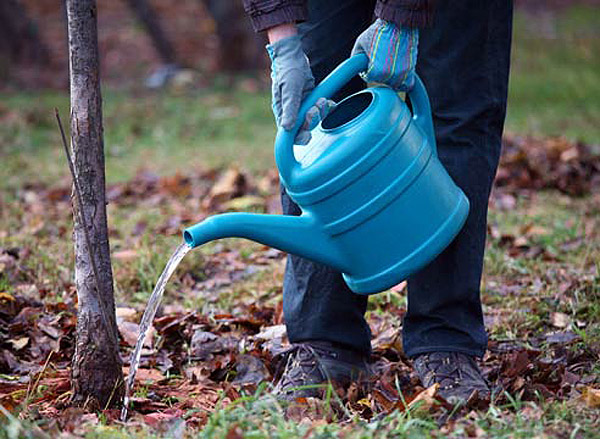 Walnut may need watering only in spring and early summer, when there is an intensive growth of green mass.
Walnut may need watering only in spring and early summer, when there is an intensive growth of green mass.
How to properly care for the cultivation process: before ripening and after
Like all fruit crops, walnut needs periodic feeding.
In the spring, nitrogen fertilizers are applied, in the second half of summer - only potash and phosphorus fertilizers, which are responsible for preparing the tree for winter and laying fruit buds for the next harvest.
On cultivated soil, nitrogen can not be fed at all, and phosphorus and potash fertilizers can be applied (in terms of the active ingredient) at 10 g / m2.
Practice shows that the rule applies to all cases when the nut does not grow on obvious stones and clay.
What is especially pleasing - in the middle lane, the walnut has no natural enemies... It has already been said that flies and mosquitoes fly around it.
Moreover, a very effective remedy against aphids and various caterpillars can be prepared from the leaves of the walnut, which is successfully used in Ukraine.
We advise: 2 kg of leaves in a bucket of water - insist until the solution darkens, or boil. You can also use dry last year's leaves.
Home remedy absolutely harmless to humans allows you to process trees and bushes with fruit and berry ovaries.
Graft
Unfortunately, walnut cuttings do not take root - propagation occurs only by seeds.
Vaccination is carried out in cases where:
- there is a seedling of probably winter-hardy Manchurian walnut, for which -40 in winter is not a problem;
- the planted variety did not live up to expectations - there was an opportunity to re-graft it.
Annual seedlings are grafted into a split and grown under control in a greenhouse to a presentation.
Young trees that have already produced the first few nuts can be re-grafted by the type of "budding with an eye" - only the bark is removed from the bud in the form of a half-tube (the method is called that) and is combined with the same cut on the rootstock.
Until complete healing, the vaccination site is tied with a film.
The result of grafting an adult walnut tree:
Reproduction in the country
The main method of obtaining seedlings is growing from seeds... To simplify the process, the nuts are planted in the fall to a depth of about 10 centimeters without additional processing. It is believed that it is best to lay them sideways at the seam.
Those who did not have time to bury them for the winter, put them in the wet sand in the basement - the nut must go through stratification, otherwise it will not hatch.
Walnut is renewed by pneumatic shoots in just a year or two. These trees are able to bear fruit literally in the second year, and at 10 - already a significant harvest.
 The main method of obtaining seedlings is growing from seeds
The main method of obtaining seedlings is growing from seeds
It turns out that walnuts can be successfully planted and grown in a country house in the middle lane, in the Moscow region. It is enough just to follow simple rules:
- the right choice of place;
- seedling - only zoned;
- obligatory mulching of the trunk circle;
- shelter of the trunk from frost in the first years of life.
All this is within the power of most gardeners.... Choose a sunny spot protected from cold winds - the walnut will thank you.
In recent years, some previously considered purely southern cultures have moved far north. Among them are persimmons, apricots, peaches, cherries and walnuts. Attempts to expand the growing area of the latter were undertaken at different times by both scientists and enthusiastic gardeners.
Professor A.K. Skvortsov devoted almost 30 years to experiments with walnuts. In 1977, he laid the first experimental plantation, which was based on seedlings grown from the fruits of trees growing on the territory of the Moscow enterprise "NIUF Experimental Plant". Later, seedlings from other places were added to them.
For many years, the plantings were closely monitored, but the final conclusion, which A.K. Skvortsov voiced in 2005, was disappointing.
In one of his articles, he wrote: “In relation to the Moscow climate, no significant features have been found that would distinguish plants grown from different batches of seeds ...
With regard to stability, they apparently depend more on the situation and on the combination of circumstances in the course of the life of each tree than on its genotype. This was to be expected, since the genetic potential of the species adaptability to more severe climatic conditions has long been practically exhausted.
This is especially evident in the plants of our reproduction: they have not shown themselves to be more resistant than their parents. "
A significant number of walnut trees can be found in the metropolitan area. One of them grows very close to Moscow, in Shcherbinka. It was grown about 22 years ago from walnuts brought from Donetsk region. The tree, covered from the winds by the wall of the house and receiving additional heat from it, does not freeze and gives, although small, but tasty and thin-bored fruits (photo 1).
Another of the walnut trees, brought by a seedling from Rostov-on-Don, grows in a dacha village near Khimki. From the north, it is reliably protected by a house and a large oak tree. Every year, the owner collects a bucket of nuts from the tree.
And for A. Bukin, a gardener near Moscow, growing walnuts has long become the most common thing. He repeatedly demonstrated his seedlings from the Leninsky district at various specialized exhibitions.
There are separate fruiting specimens of walnuts in Kratovo, Kolomna, Ruza and other settlements of the Moscow region.
In addition, I know of two trees obtained from Baltic nuts and growing in the Aptekarsky Ogorod (Botanical Garden of Moscow State University, Moscow), as well as one specimen in the Novogireevo area (in the east of Moscow).
Probably the northernmost walnut plantation was established in the stronghold of the Leningrad Botanical Garden, located 100 km north of the city, on the Karelian Isthmus, in the village. It is gratifying. The botanist I.N.Konovalov was engaged in the introduction of this plant from the beginning of the 50s.
The big science is silent about the results of those experiments, but in the Botanical Garden of St. Petersburg trees grown from walnut fruits of Konovalov's selection grow and live. True, in unfavorable years, due to a lack of heat, the fruits do not ripen on them.
There are at least two more walnut trees in the city on the Neva. One of them is on the street. Yesenin, grows in a strong thickening and looks depressed, although at the same time it bears poor fruit.
But the second one - on the Morskaya embankment - feels pretty good (photo 2). More than 20 years ago, it was planted by an amateur gardener Valery Yevtushenko with a seedling brought from Rostov.
For the second decade, the tree has been giving bountiful harvests. As the owner himself notes, sometimes there are more than two hundred nuts per season.
Until now, we were talking about ordinary nuts, which begin to bear fruit ten years after planting. But our colleague Valery Goryachev from Krasnoarmeyets, Moscow Region, managed to grow a fast-growing dwarf hybrid nut of I. Levin's selection. This nut gave its first harvest after 4 years (photo 3)
See also: Korenovskiy walnut - frost-resistant variety "Ideal"
At the same time, the gardener does not cover his seedling in any way.
As you can see, walnuts are not so rare in the middle lane, although they are not very stable - they often freeze and remain without a crop.
Nevertheless, most gardeners can grow it. The main thing is to create favorable conditions for the nut - to provide a sunny location, protected from strong cold winds.
Most of the plants I have seen are in such conditions, under the cover of trees, fences or buildings.
And although Professor A.K. Skvortsov argued that walnut plants from different regions differ little among themselves in terms of resistance, it seems to me important where the planting material is taken from.
For example, I have a seedling grown from a Crimean nut, even under the snow, it freezes almost to the ground every year, and the seedlings obtained from plants near Moscow and Kharkov, for the most part, did not seem to notice the past winter at all.
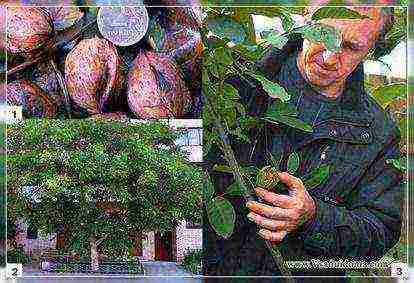
So, in my opinion, walnuts, albeit with some reservations, can be grown in regions with a completely non-southern climate.
The experience will be crowned with a large nut!
Until yesterday, no one could even think about growing a thermophilic walnut in Central Russia. Today, thanks to domestic breeders, this becomes possible. Still, adapting culture to local conditions is not easy.
What are the best walnut seedlings?
The boundaries of the natural distribution of walnuts are the Krasnodar Territory and the North Caucasus. In the central Russian latitudes, southern seedlings are severely frozen in winter, and in spring their shoots die from nighttime cold snaps. As a result, the culture turns into a stunted, stunted tree that does not yield a harvest. Therefore, experiments with walnut seedlings brought from areas with a warm climate do not give positive results. How to be?
Breeders have found among all varieties of walnuts the most frost-resistant forms. They took seedlings from the highlands of the Caucasus and Central Asia, where the temperature in winter sometimes drops to 40 °.
There, in the walnut forests, plants are represented in the wild. Cultivated winter-hardy varieties were found among gardeners in the Belgorod, Voronezh, Bryansk, Kursk regions of Russia, as well as in the Baltic States, Belarus and Ukraine in the Kharkov region. When growing seedlings in these latitudes, the varieties Kamenskiy, Voronezhskiy, Krepysh and Shevgenya proved to be the best.
Another way is selection. The gardeners took the fruits of nuts collected in the mountainous regions of Dagestan and Ukraine. They planted them in the gardens of the Moscow region. And then from the obtained seedlings, already slightly adapted to local conditions, the most frost-resistant were selected. These seedlings were able to develop into trees of normal size and bear fruit. The breeders sowed the nuts that grew in the harsh climate and produced even more winter-hardy plants. From their fruits, seedlings of the third generation emerged even more adapted to the conditions of Central Russia.
Is it worth the risk?
Used by gardeners and the method of crossing plants of different species - the so-called interspecific hybridization. They took seedlings of the Manchu nut (a frost-resistant relative of the walnut, but with a lower quality of fruit - a thick shell and a small kernel) and pollinated its flowers with walnut pollen. From the fruits that grew after this, the breeders selected those that most resemble walnuts in appearance and taste. We planted the seeds, and when the seedlings grew up, we took from them trees that look like a walnut and give appropriate fruits. True, from these fruits, which are identical in appearance to walnuts, seedlings of the Manchurian nut still grow.
Certain difficulties have arisen with the fact that walnut trees, accustomed to the long growing season in the south, suffer greatly from spring and autumn frosts in our country. Gardeners manage to force them to bloom later in the spring by collecting snowdrifts around the boles and covering the snow with boards from rapid melting. Then, on cold nights, a non-woven material is thrown over the trees.And in the fall (at the end of August - in the first days of September), the ends of non-lignified branches are pinched at the seedlings, and phosphorus-potassium fertilizing is applied under them. For trees, this is a signal for the end of shoot growth and preparation for winter.
So far, work on the adaptation of walnuts for the central regions of Russia has not yet been completed. But there are already some experimental plantings in the Moscow region, the Leningrad region, where the trees grow and bear fruit well. The first varieties with all the necessary qualities were obtained: high winter hardiness, early maturity, late flowering, with large and tasty fruits, thin shells. These are Osipov, Ideal, Old Man Makhno, V Elite.
You can already find and purchase seedlings of these varieties for yourself in many nurseries, so do not be afraid to experiment, for sure the experience will be crowned with a large nut!
Walnut: food for the mind
In the middle lane, it is best to plant walnut seedlings in the spring, after the ground has thawed and the danger of recurrent frosts has passed. In the spring, grafted seedlings are planted, and seedlings are transplanted to a permanent place.
The grafted plants are planted only in the spring to protect them from winter damage. The best time in our latitudes is from mid to late April. Seedlings grown from seeds, as more winter-hardy, can be planted in a permanent place in the fall.
Where to plant walnuts
Walnut prefers flat terrain. It also feels good on the middle and upper parts of the small slopes, southern and western. Planting walnuts in the lowlands is unacceptable: in the off-season, in spring and autumn, rain and melt water accumulates there, cold air stagnates. The best option for growing walnuts in our latitudes is planting from the southern and southwestern sides of buildings, near the walls. This will increase the amount of active summer temperatures by several degrees, and the buildings will also protect the plants from the wind. But plants planted too close to the house, growing, with their powerful roots, can damage the foundation of buildings.
Neighbors are undesirable
There is hardly anything growing under the branches of the walnut tree. First, the vast and deep root system of the plant selects all nutrients from the ground, leaving nothing to the neighboring plants. In addition, walnut leaves contain juglone, an element toxic to other plants.
Some vigorous walnut varieties at the age of 25-30 have a crown diameter of 8-12 meters. Not far from the walnut, only berry bushes feel good. They manage to give a good harvest in five or ten years, and when the tree grows, they can be uprooted.
Digging a hole for a walnut in the fall
It is recommended to prepare a planting hole for walnuts in the fall. Most of the root system of a walnut is located in the projection area of the crown of the tree. In an annual seedling, the roots penetrate into the soil to a depth of two meters, and in an adult plant, tens of meters deep. Therefore, a mature tree can adapt to different soils by extracting missing elements from different layers. But while the plant is young, it is very important for its proper development that the soil around (about a meter across) is suitable for it.
If the planting hole is properly prepared, it will be able to provide the young plant with the nutrients it needs for the first five years, until the root system gets stronger and the plant adapts to the growing conditions. The size of the planting pit ranges from 60 cm in diameter and 60 cm in depth to a meter in diameter and a meter in depth. If the humus layer (on fertile soils)
The skeletal roots of the walnut should be located at a depth of about 60 cm. This allows the plant to suffer less from cold in winter and drought in summer.If the hole is not deep enough, the root system of the nut will be too close to the soil surface and be injured, the plant will experience a lack of nutrients (25-30 cm), the hole may be smaller, if the soil is not so fertile, a larger planting hole is needed.
As usual when planting fruit trees, when digging holes, the upper fertile layer and the lower, infertile layer are separated. It is necessary to fill the hole with a substrate consisting of the upper fertile layer of soil, peat and humus, taken in equal shares.
When planting walnut seedlings, fresh organic matter must not be introduced into the planting pit. Not decomposed will damage the roots of the seedling, and this will prevent the penetration of the root system of the plant into the deeper layers of the soil.
When preparing the planting holes, it is necessary to apply mineral fertilizers. For one plant - about 3 kg of superphosphate, up to 800 g of potassium chloride, from 500 g to 1 kg of dolomite flour, 1.5-2 kg of ash, which will become a source of trace elements valuable for the plant. You can replace these mineral fertilizers with 200-250 g of nitroammophoska for each planting pit.
Fertilizers must be evenly mixed with the substrate, after which the pit should be filled with the mixture by two-thirds of its volume. After filling the hole, it is watered (about 20 liters of water per hole), after which a support stake with a height of about one and a half to two meters is installed in its center. When the water is absorbed, a planting hill is poured in the center of the pit, 3-5 cm above ground level. When planting a walnut, the root collar of the seedling should be at ground level. After planting, the soil will settle, and the root collar can go underground. To avoid this, it is necessary to make sure that the planting mound is above the soil level.
In a walnut, the root collar is clearly distinguished: the central root is very thickened and the place of its transition into the trunk is clearly visible.
Preparing seedlings for planting
Before planting, the seedlings must be inspected. Broken branches are removed, damaged roots are carefully trimmed. After that, the roots are dipped in a clay mash, its composition is decomposed manure (one part) and clay (three parts). Growth stimulants - Epin or Humate can be added to the chatterbox.
Planting is done in the same way as any other garden trees. The plant is placed in a hole on compacted soil (root collar 3-4 cm above ground level). The roots must be carefully spread over the entire diameter of the planting mound, covered with a mixture of fertile soil with fertilizers, tamped and trampled down, watered for better adherence of the earth to the roots (from 3 to 6 buckets of water per plant). After the water is absorbed, the trunk circle must be mulched with a thin layer of humus, chopped straw, peat, etc. From the infertile soil that was taken from the bottom of the planting pit, you can make a hole around the tree. The seedling must be tied to a peg: in a walnut, the crown has a large windage due to large leaves (up to 40-50 cm or more in length), and the wind can damage a fragile tree.
Below are other entries on the topic "Cottage and garden - do it yourself"
Early-fruiting walnut (photo) - planting and care: Early-fruiting variety of walnut - ... Walnut: benefits and cultivation: Planting a walnut in the garden ... Growing a walnut - care and reproduction: Walnut: "bread" for heroes Once upon a time ... Walnut walnut with seedlings in the Middle Lane: Growing walnut with seedlings in ... Planting and growing a walnut - gardener's advice: Walnut - the right planting ... Pecan (photo) - planting and care: Growing a pecan To a friend, relatives from ... Reproduction of a walnut and an overview of some interesting varieties: Walnut - what varieties ...
Subscribe to updates in our groups.
Let's be friends!
How to grow a nut in the middle lane
Over the past few years, cultures previously considered exclusively southern have spread to the northern part. Among them are apricots, cherries, peaches, persimmons and walnuts. Growing walnuts in the middle lane at the moment is quite possible. Quite a lot of trees can be seen in the Moscow region. One of them grows in Shcherbinka, near Moscow. The wall of the house covers it from the wind and also provides additional warmth.
Walnut, imported from Rostov-on-Don, also grows near Khimki. The tree is also protected by the wall of the house, there is a large oak nearby, which protects the walnut from the wind. Every year, the owner manages to collect a bucket of nuts.
So what needs to be done so that growing walnuts in the middle lane does not turn out to be wasted time?
This plant is distinguished by its resistance to cold, unpretentiousness. In order to grow a nut, special efforts are not required, it is still worth familiarizing yourself with the theory. After reading one or two specialized articles, you will learn how to grow walnuts in the middle lane. Walnut, although it can withstand low temperatures, loves warmth and light. Do not worry if in winter the shoots are damaged or even die, since the tree is distinguished by rapid self-healing, which contributes to the growth of new ones. For growing in the middle and northern lane, it is better to use a frost-resistant tree variety with a powerful root system. The roots penetrate deep into the earthen layer, so they are not afraid of winter frosts.
Reproduction methods
Many people are interested in where walnuts grow in Russia and how to propagate them. There are several ways to propagate walnuts. Alternatively, you can purchase a grafted four-year-old tree, the crown of which has already begun to form. The seeds are also good for planting. Better to plant them in the fall or spring. It is better to use the seeds of past crops, after soaking them for several days in warm water. It is necessary to make a furrow into which the seeds will be sown. The depth should be 8 centimeters. Practice has shown that it is better to plant nuts in autumn, because seedlings are more viable and strong.
If planted in spring, early May is best. Seeds must be germinated before planting. Towards the end of January, the seeds are planted in small containers filled with peat with the addition of wet river sand. After that, the seeds are harvested in a room where the air temperature does not exceed 7 degrees. Choose in advance the area where the tree will grow, as the germinated seeds are planted in a permanent place. It is desirable that this area has protection from the wind and is sufficiently well lit. The distance between seeds should not be less than 75 centimeters. Cover, place the seeds on the sides, and then level the soil from above and start watering. The first shoots should appear in two weeks.
After sifting, throughout the year, the plants need to be looked after regularly. It is necessary to remove all weeds in a timely manner, loosen the ground and provide periodic watering. Sunflower or corn can be planted between the rows so that young walnut seedlings do not suffer from wind or snow in winter.
If you refused to plant seeds in favor of a young tree, the plant is endowed with all the positive varietal properties.
A little about the problems
There are times when among healthy trees there are damaged or neglected nuts with an unkempt appearance. As a rule, they produce smaller nuts or cease to bear fruit altogether. At the same time, the growth of a tree can stop completely or vice versa, gain intensity, in comparison with others. If the plant is already many years old, then there is no point in treating it and trying to restore it. It is better to dig up this tree altogether, planting a young seedling in its place.If a diseased tree has been growing for only a few years and has a strong skeleton, then its properties can be restored by providing proper care.
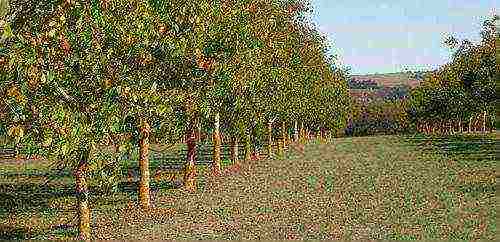
First of all, carefully examine it for a variety of pests or diseases. Having discovered, it is imperative to take corrective measures. In addition, all affected, dry and diseased branches must be removed. The land must be fertilized, and the trunk of the nut must be partially pulsed.
How to grow walnuts in the middle lane: Video

